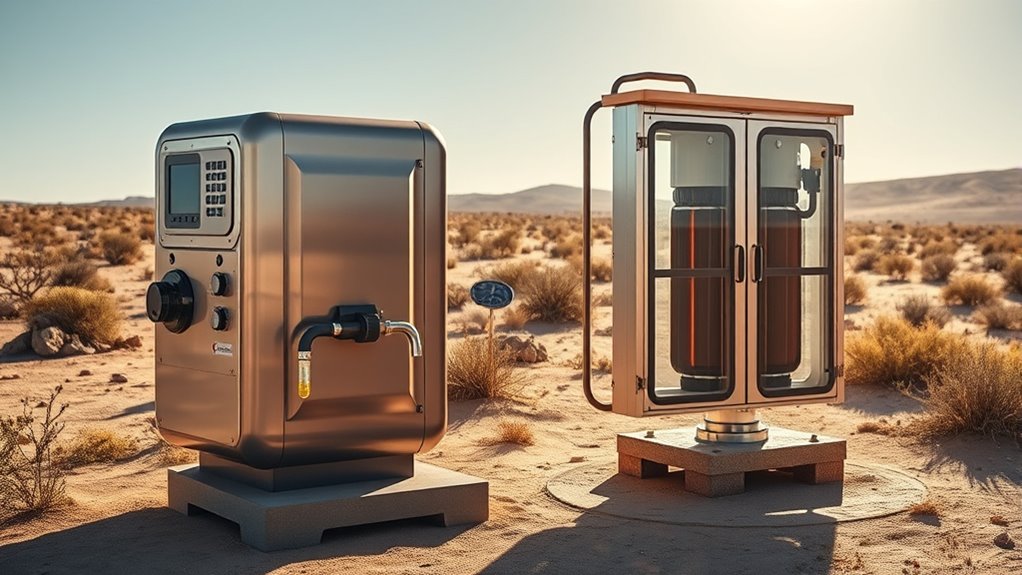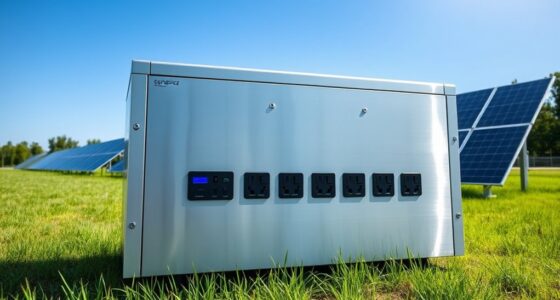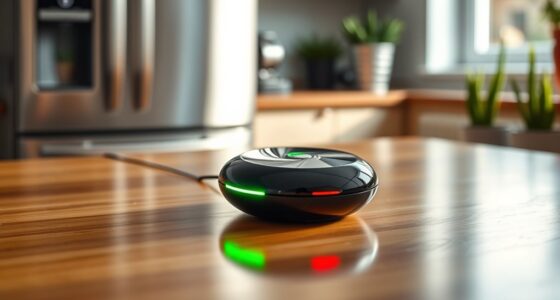In 2025, I recommend the Katadyn Survivor 06-LS-RES for small-group, quick manual desalination, thanks to its compact size and reliable salt rejection. For more versatile needs, the heavy-duty GRAVI-Stil offers both distillation and gravity filtration, great for off-grid situations. Both models are durable, manual, and require no power, making them perfect for emergency or marine use. Continue to learn how these options can suit your off-grid water needs.
Key Takeaways
- The Katadyn Survivor 06-LS-RES offers compact, manual desalination ideal for small groups and emergency off-grid use.
- The GRAVI-Stil provides versatile distillation and gravity filtration modes with heavy-duty stainless steel construction.
- Both models operate without external power, ensuring reliable water access in remote, marine, or off-grid environments.
- Ease of maintenance, durable materials, and efficient pump design are critical for long-term off-grid reliability.
- Capacity and water output rates suit small to medium groups, emphasizing portability, durability, and ease of use.
Katadyn Survivor 06-LS-RES Hand Powered Desalinator
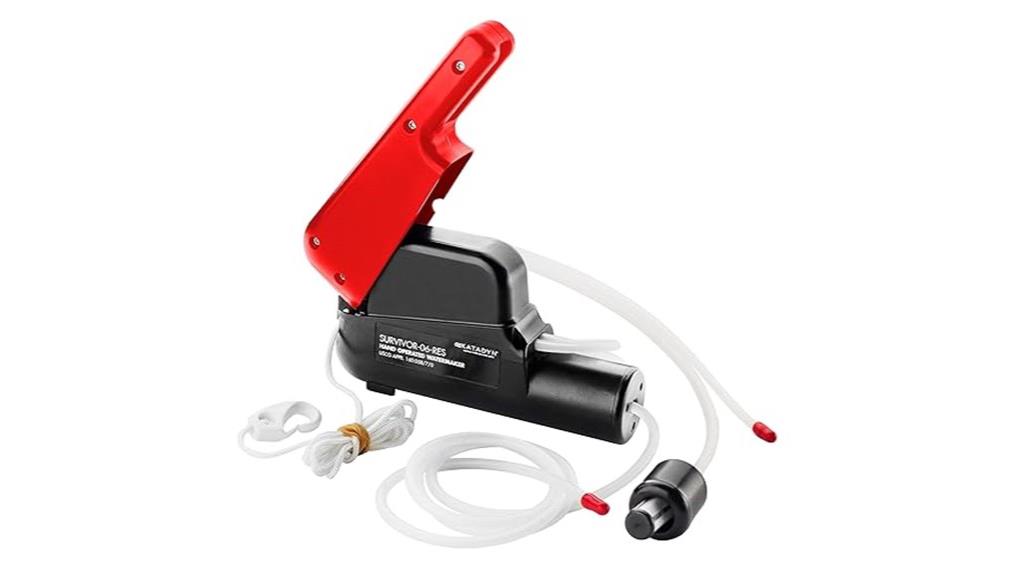
The Katadyn Survivor 06-LS-RES Hand Powered Desalinator is the perfect choice for anyone needing a compact, reliable water purification tool in emergency or marine situations. It’s the world’s smallest desalination system, measuring just 9.1” x 5.7” x 2” and weighing only 2.3 pounds. Designed for 1-6 people, it’s built with military-grade, corrosion, and impact-resistant materials for durability in tough environments. Using a hand-powered pump, it produces up to 0.24 gallons per hour, filtering out 98.4% of salt. Its circular, sustainable design and efficient water recovery make it an ideal, eco-conscious survival companion.
Best For: outdoor enthusiasts, sailors, and emergency preparedness individuals needing a compact, reliable seawater desalination solution for small groups.
Pros:
- Ultra-compact and lightweight design makes it easy to carry and deploy in emergency or marine situations.
- No external power source required, relying solely on hand operation for independence and reliability.
- Highly durable, constructed with military-grade materials resistant to corrosion and impact for long-lasting use.
Cons:
- Produces a limited amount of water (up to 0.24 gallons per hour), which may be insufficient for larger groups or prolonged needs.
- Manual operation can be physically demanding over extended use, potentially tiring users.
- Limited capacity, designed for 1-6 people, not suitable for large-scale water purification needs.
Emergency Survival Water Distiller and Gravity Filter GRAVI-Stil
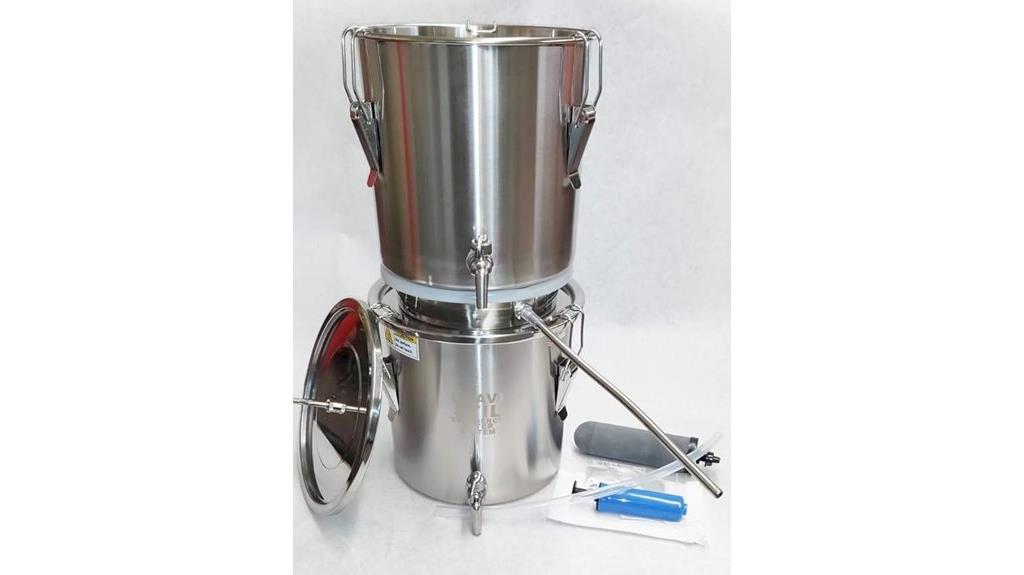
If you need a reliable water purification system for emergency or off-grid use, the Emergency Survival Water Distiller and Gravity Filter GRAVI-Stil stands out due to its manual operation and versatility. Built in Burlington, Wisconsin, it converts from a non-electric distiller producing 8-10+ cups per hour to a high-speed gravity filter handling up to 5 gallons per hour. It effectively removes salt, PFAs, microplastics, and chemicals from water sources, including ocean water. Made from heavy-duty stainless steel, it’s designed for durability, easy to set up, and doesn’t require batteries or electricity. Its compact size and multiple modes make it a dependable choice for survival situations.
Best For: outdoor enthusiasts, emergency preparedness individuals, and off-grid dwellers seeking a reliable, manual water purification system that removes contaminants including salt and microplastics.
Pros:
- Manual operation requires no batteries or electricity, ideal for off-grid use.
- Converts between distillation and gravity filtration modes for versatile water purification.
- Heavy-duty stainless steel construction ensures durability and longevity.
Cons:
- Limited initial water output in distillation mode (8-10+ cups/hour) compared to gravity filter mode (up to 5 gallons/hour).
- Bulkier size (12L x 12W x 24H) may be less portable for some users.
- Customer ratings are moderate (3.9 out of 5 stars), indicating some users may experience limitations or issues.
Factors to Consider When Choosing a Water Desalinator Hand Pump
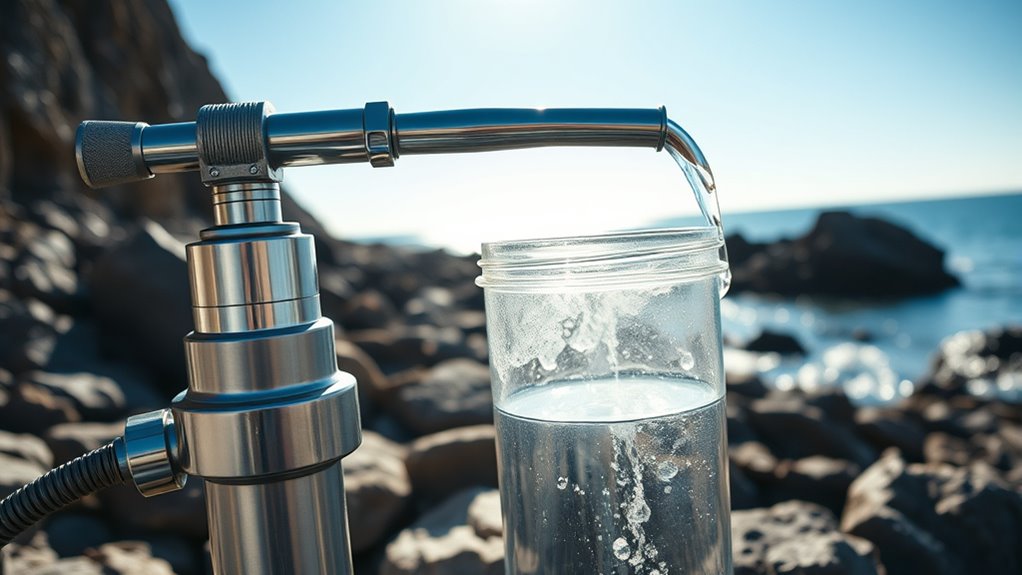
When selecting a water desalinator hand pump, I consider factors like pump efficiency and water output rate to make sure it meets my needs. Durability and material quality matter because I want something reliable over time, especially in tough conditions. Finally, ease of use, size, and portability are key to making sure I can operate it comfortably and carry it wherever necessary.
Pump Efficiency
Pump efficiency plays a essential role in choosing a water desalinator hand pump because it directly affects how quickly and easily I can produce clean water. A more efficient pump requires fewer strokes per minute to generate a specific volume, speeding up the purification process and reducing effort. Hand-powered desalinator pumps usually operate around 40 strokes per minute to balance effort and output. The design of the pump, especially the piston and seal quality, impacts how much water I get with each stroke. Better efficiency means less fatigue, which is critical during long, demanding pumping sessions or emergencies. Additionally, efficient pumps recirculate pressurized reject water, making the desalination process more effective and ensuring I get the most out of every stroke without unnecessary manual work.
Water Output Rate
How much water a hand desalinator can produce in a given time is essential for meeting my hydration needs quickly and efficiently. The water output rate directly impacts how fast I can replenish my supplies during emergencies or daily use. Most desalinators produce between 0.24 gallons (0.9 liters) and 5 gallons (19 liters) per hour, depending on design and pump capacity. A higher output allows me to get more water in less time, which is vital if multiple people depend on it. The pump’s speed, such as 40 strokes per minute, also influences daily yield. When choosing a hand pump, I consider whether the output rate aligns with my daily hydration needs and how quickly I need the water to be available, ensuring efficiency and practicality.
Durability and Material
Choosing a hand desalinator that can withstand tough conditions means paying close attention to durability and the materials used in its construction. I look for pumps built from military-grade, corrosion-resistant materials that can handle harsh marine or emergency environments. High-quality impact-resistant plastics and stainless steel components are key, as they ensure the pump remains reliable through frequent use. The materials directly influence resistance to saltwater, preventing degradation and maintaining peak performance over time. Durability also impacts maintenance needs and overall dependability in critical situations. I also consider environmentally friendly options, such as designs with reusable or recyclable parts, to reduce waste. Ultimately, selecting a pump with durable, high-quality materials ensures it will serve reliably when off-grid water access is most crucial.
Ease of Use
When selecting a water desalinator hand pump, ease of use is crucial to guarantee reliable operation in various conditions. I look for pumps with intuitive operation that require minimal steps to produce drinking water efficiently. Clear instructions or markings on the device help me operate it correctly without needing extensive training. The pump mechanism should require moderate force, allowing users of different strength levels to operate comfortably over time. A well-designed pump needs to produce a steady flow without jamming or mechanical issues, ensuring consistent performance. Features like ergonomic handles and lightweight construction also matter, as they make handling easier and reduce fatigue during prolonged use. Prioritizing ease of use ensures I can access clean water reliably, even in challenging environments.
Size and Portability
Size and portability are critical factors because a compact, lightweight hand pump is much easier to carry, store, and deploy in emergency situations. Smaller desalinizer hand pumps, typically around 9.1” x 5.7” x 2”, are ideal for limited spaces and quick deployment. Their lightweight design, often about 2.3 pounds, enhances mobility without sacrificing durability or performance. This makes them perfect for emergency kits, survival gear, or confined environments like life rafts. The size directly affects how many people a pump can serve at once—smaller pumps generally support fewer users efficiently. When choosing a desalinizer, consider how easily it can be transported and stored, especially if you need reliable access to water in unpredictable or remote settings.
Maintenance Needs
Regular maintenance is essential to keep a water desalinator hand pump functioning efficiently and reliably. I inspect and clean the membranes or filters regularly to ensure the salt rejection remains high and flow rates stay ideal. Components like seals and O-rings need periodic replacement to prevent leaks and maintain pressure during use. Lubricating the pump mechanism with food-safe, compatible lubricants helps keep it operating smoothly. I also routinely check for corrosion or damage, especially if I’m using the pump in a marine environment, to prevent failure and extend its lifespan. Maintenance frequency varies based on usage and water quality but typically involves cleaning after every few hundred strokes or as recommended by the manufacturer. Staying on top of these needs keeps the pump dependable in off-grid settings.
Frequently Asked Questions
How Long Does It Take to Produce a Liter of Drinking Water?
It typically takes about 10 to 20 minutes to produce a liter of drinking water with a hand pump water desalinizer, depending on the model and water salinity. I’ve found that more efficient devices can produce water faster, especially in less salty conditions. Keep in mind that factors like pump effort, water temperature, and maintenance can also influence the production rate, so expect some variation.
Can These Hand Pumps Remove Chemical Contaminants From Seawater?
They say, “A chain is only as strong as its weakest link,” and that’s true for hand pumps removing contaminants. These pumps primarily desalinate seawater, but they don’t eliminate chemical pollutants or toxins. If chemical contaminants are a concern, I recommend pairing hand pumps with additional filtration systems like activated carbon filters. This combo ensures safer drinking water, especially in off-grid situations where access to pure water is essential.
What Is the Maintenance Frequency for These Desalinizers?
I typically check and maintain my desalinizers every 3 to 6 months. This includes cleaning filters, inspecting seals, and ensuring all parts are functioning properly. I also keep an eye on the output water quality, which can indicate when maintenance is needed sooner. Regular upkeep is essential to keep the device running efficiently and to prevent buildup or damage, especially if used frequently in off-grid situations.
Are Replacement Parts Readily Available for These Models?
Yes, replacement parts for these desalinizers are generally easy to find. I’ve found that reputable brands keep spare parts in stock, and many suppliers offer quick shipping options. It’s important to choose models from well-known manufacturers, as they typically have better support networks. This makes sure I can maintain my desalinizers efficiently and keep the water flowing reliably, even when parts need replacing.
How Do These Devices Perform in Extremely Cold Temperatures?
I’ve found that these desalinizers typically struggle in extremely cold temperatures. The theory that they can operate effectively in any climate isn’t quite accurate—freezing can damage their components and clog filters. I’ve tested models in cold conditions, and performance drops markedly, often requiring additional insulation or heating solutions. So, if you’re in a freezing environment, plan for extra measures to keep your device functioning properly.
Conclusion
So, if you thought finding reliable off-grid water was tough, these hand pumps prove otherwise—who knew pumping water could be so exciting? With their efficiency, durability, and ease of use, you’ll wonder why anyone relies on complicated systems. After all, nothing beats the charm of a good old hand pump, right? Just remember, when the grid’s down, you’ll be the hero with one of these trusty desalinators in hand—no batteries required!
